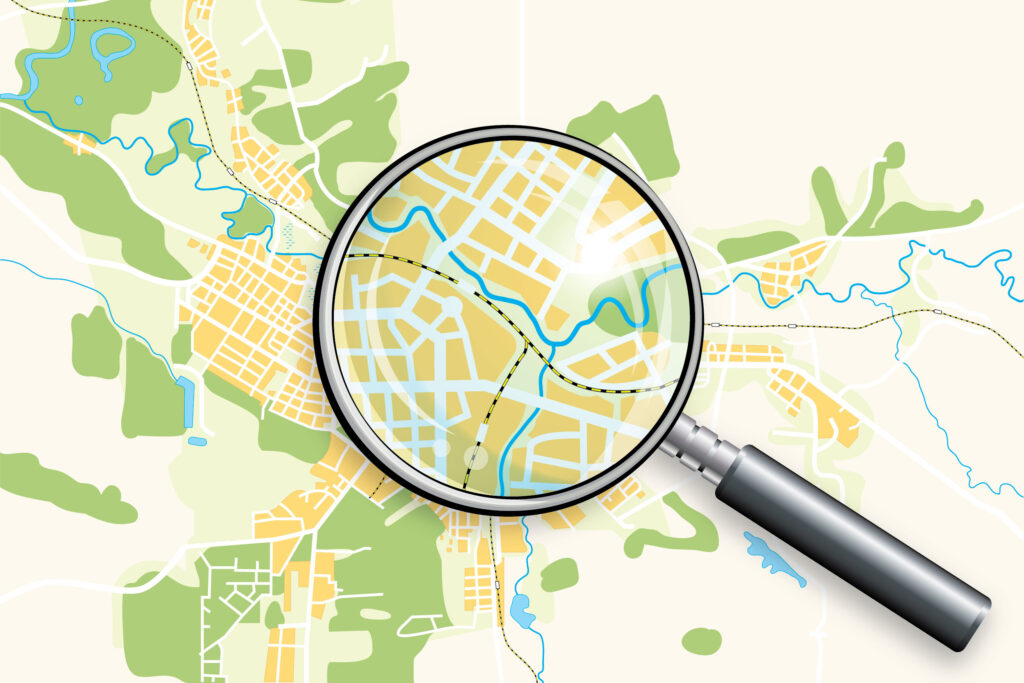Planning for future growth necessitates a high degree of stakeholder engagement no matter the size of the region or the scope of the initiative. In addition to helping planners understand the needs and desires of those who will be directly impacted, engaging with the community also fosters trust and understanding. Connecting constituents to the process guides the creation of a plan that is realistic and relevant. However, without a clear and accessible implementation roadmap, even a well-crafted deliverable that accurately reflects the wishes of stakeholders holds little value. Specific, measurable goals and publicly available progress-tracking tools like an implementation matrix or dashboard are essential for accountability and transparency in achieving long-term objectives.
GIS (geographic information systems) is an especially effective tool for tracking the status of specific, place-based projects like infrastructure improvements. Large cities and metropolitan planning organizations often have multiple long-range plans and studies concerned with improving mobility. These initiatives could include a comprehensive plan with a mobility element, an active transportation plan, a transit-oriented development plan, a corridor improvement plan, and others. When trying to parse multiple transportation-related plans, it can be hard to make project goals and implementation methods apparent to stakeholders, with overlapping plans from multiple city departments or local jurisdictions rendering implementation responsibilities, project details, and construction timelines unclear. GIS maps tracking implementation of ongoing and future projects that align with plan goals can help stakeholders see the progress being made toward their vision, representing a transparent implementation process. The following three examples illustrate the power of place-based implementation tools.
In 2022, the North Central Texas Council of Governments (NCTCOG) adopted its current long-term transportation plan, the Mobility 2025 Update. As part of this blueprint for a quality multimodal transportation system, NCTCOG outlines its latest recommendations for the Regional Veloweb, a planned area-wide network of more than 8,600 miles of shared-use paths in various stages of development in the Dallas-Fort Worth area. When considering the collection of existing mobility networks and various active transportation plans that can be found across its 16 counties and nearly 170 member cities, NCTCOG faces a daunting task in making policy recommendations that synthesize the desires and needs of member communities. Even with cohesive planning efforts and policy recommendations, it can be hard for stakeholders to keep track of where progress is being made at the regional level. To communicate current progress toward this vision at a single web address, NCTCOG hosts an interactive map of trails and on-street bikeways, displaying the current status of planned, funded, and existing routes in the North Central Texas region. By providing users an up-to-date look at the shared-use trail system, the map serves as both a useful tool for cyclists looking for designated trails and a demonstration of the progress being made toward a more cyclist- and pedestrian-friendly regional transportation system.
The City of Austin offers a similar tool for tracking improvements to local walkways. Since its adoption in 2019, the Austin Strategic Mobility Plan has guided the city’s development of a safe and equitable pedestrian experience. In pursuit of the Mobility Plan’s goals, the ATX Walk Bike Roll program produced an updated Bicycle Plan, an updated Urban Trails Plan, and the 2023 Sidewalks, Crossings, and Shared Streets Plan. The latter plan details the city’s strategy for improving its network of sidewalks and Shared Streets—a traffic calming-based retrofit for neighborhoods without sidewalks. With multilateral transportation plans of different scopes being implemented simultaneously, the city recognized the need for a single tool to keep residents informed of progress. Maintained by the Public Works Department, the Sidewalk Program Projects Map illustrates the up-to-date status of sidewalk and curb ramp maintenance as well as Shared Streets projects throughout Austin. The map allows users to see current and near-term projects, as well as those that have been completed since 2011. By maintaining a database of citywide projects, the City of Austin ensures that residents and stakeholders can see tangible progress being made on a variety of long-term planning visions, rewarding them for their investment and participation in the planning process.
Seattle is also undergoing a range of improvements to the city’s active transportation system, with Healthy Streets, Neighborhood Greenways, and protected bike lanes and trails serving distinct, but overlapping, roles in pursuit of a network of safer neighborhood streets that prioritize walking and biking. To those ends, the city hosts the Bike Implementation Project map, which illustrates ongoing and planned improvements to Seattle’s greenways, protected bike lanes, healthy streets, and shared-use paths. It also includes an interactive tooltip on project segments that redirects users to project-specific webpages where they can see details like funding, planned amenities, timelines, and construction updates. This tool allows users to quickly see extensive details on project elements and construction specifics, as well as how upcoming changes will fit into the existing bike network, keeping residents informed of how the city is implementing its Bicycle Master Plan.
While stakeholder engagement is critical throughout the development of a long-term plan, it is also essential that implementation is transparent and well-documented, with stakeholders able to see their vision for the community’s future realized in real time. In addition to providing user-friendly maps that are readily accessible to residents, GIS is a valuable tool for delivering progress reports to stakeholders when implementation plans and matrices are spread across numerous documents delivered by multiple local government departments.



